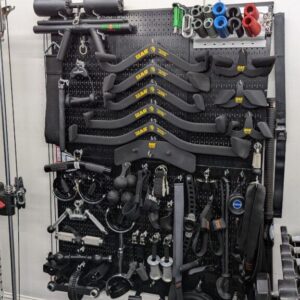Should Powerlifters Do Cardio? Yes, and this is how!
Should Powerlifters Do Cardio? This is a common question, and on the surface it makes sense. In powerlifting, the pursuit of maximal strength is the top priority. Thus, there is an idea that cardio training will inevitably interfere with strength gains or hinder recovery within the powerlifting community. However, when implemented strategically, cardio training can complement strength training efforts, enhance conditioning, improve body composition, and promote efficient recovery. Not to mention, there are general health benefits to maintaining your cardiovascular health. And if you are a lifter that is bound to a particular weight class, implementing cardio can aid in weight maintenance without forcing a restriction of caloric intake.
That said, cardio can have an adverse impact on strength training if done in a way that it taps into our ability to recover properly between sessions. So you have to do it correctly!
Table of Contents

Transparency Note
Some of the items and links in this article might be affiliate links, or might be linked to a Sponsor of the Garage Gym Competition. These links and sponsorships help fund the website, the competition itself, the newsletter, non-profit donations, and everything else we do FOR FREE here at the GGC. I like to be transparent so you know what is up. I appreciate the support if you choose to use the links.
Does Cardio Ruin My Gainz?
Cardiovascular training does not inherently compromise strength gains. Contrary to popular belief, implementing cardio into one’s weekly powerlifting routine can enhance overall conditioning without detracting from strength development. Properly programmed cardio can facilitate recovery by promoting blood flow, aiding in nutrient delivery to muscles, and reducing post-exercise soreness. When balanced with strength training and recovery protocols, cardio becomes a valuable tool for optimizing performance.
The key to implementing cardio training for powerlifters lies in strategic programming and individual customization. The factors that must be taken into consideration for strength athletes are:
- choosing the right cardio options
- managing intensity and volume
Powerlifters can reap the benefits of cardiovascular training, while continuing to make progress in strength and powerlifting-specific skills, while enhancing their cardiovascular health.
Cardio Options for a Powerlifter
Luckily, we don’t have just one type of cardio. Options include going for a brisk walk, utilizing a cardio machine, sled work, strongman conditioning, or basically anything that gets your heart pumping. While each of the methods can be applied by a strength athlete, there is not a one size fits all approach to the implementation of these methods. For example, if a powerlifter already has a good conditioning base, taking a brisk walk may not be enough to get their heart rate up. They might have to add in tools such as a weighted vest or sled to create enough of a challenge for the walk to still be effective.
Examples of Cardio Options
Brisk Walking: 30-60 minutes at a conversational pace. Wearing a weight vest is permissible if walking is otherwise not having the desired effect.
Cardio Equipment: 30-60 minutes of work at a conversational pace. This does not have to be restricted to one piece of equipment for the entire duration. You could choose an AirDyne for 10 minutes, Rower or Ski-Erg for 10 minutes, Walk at a brisk pace for 10 minutes, etc. Use any cardio pieces you want to achieve the full 30-60 minute session.
Sled Work: This should be kept light, 25% of your bodyweight or less. Using an empty sled is absolutely fine as well! Do sled drags for timed rounds, steady state work (20-30 min), or set a goal distance for time.
Strongman Conditioning: Think medleys or circuits. My favorite is light kettlebell circuits or various movements of my choice. No movement is really off-limits here as long as the weight is kept light enough to have a cardiovascular impact and not fatigue your muscles.
HIIT Training: I am a fan of High-Intensity Interval Training as a cardio method, but powerlifters must be cautious of fatigue management when using high-intensity methods for conditioning as they could impact recovery.

Here is an example of how I implement cardio and strength training throughout a week. Remember that MY plan might differ from yours for a number of reasons, so use this as an example and not a copy and paste activity.
| Monday | Tuesday | Wednesday | Thursday | Friday | Saturday | Sunday |
| Squats | Press | 40-minute Brisk Walk w/ Vest | Deadlift | Bench | 30-minute Light KB Complex | REST |
Managing Intensity and Volume
As mentioned, this will be based on the individual. Individualization (which we have touched on briefly) includes customizing cardio programming based on individual recovery abilities, training goals, and lifestyle factors. If you are more fit, you can already handle more. If you think a set of 5 reps is cardio, then we probably need to start slower. Progressive implementation through the gradual increase of cardio volume and intensity will ensure adaptation without hindering recovery ability.
Strategic timing of cardio sessions is important as well. Putting a hard and heavy cardio workout the day before a heavy squat session might not be wise. Instead, plan your week to allow for sufficient rest between sessions to prioritize recovery.
Planning Cardio For A Powerlifter
A good principal is that the farther away you are from competition, the more generalized your training should be. And the closer you are to competition, the more focused it should be. Even if your goal is ultimately to have a bigger Total, when you are far outside of a competition, you can spend less time focused on that specific goal, and more time spent building yourself as a complete athlete. So we need to keep an eye on our recovery as we transition from one phase to the next.
Thus, during the off-season or a hypertrophy block, you can do MORE cardio at HIGHER intensities. This will help improve aerobic capacity and manage body composition. With a better aerobic capacity, you will recover better from the more demanding strength workouts to follow during your strength blocks.
During strength blocks you should prioritize strength training while incorporating cardio sessions to maintain cardiovascular fitness and aid recovery.
During peaking cycles, say a couple of weeks out from the next Garage Gym Competition, we must reduce our cardio volume and intensity to prioritize recovery and optimize performance for the upcoming meet (super compensation). Keep your eyes on the prize so to speak. This is not to say that we stop cardio all together during our peaking cycle, but it should be reduced, and recovery should be closely monitored to allow for super compensation.
Once we have reached our peaking cycle, we should be within a comfortable range of our weight class (if bound by such) and the final few pounds that we need to shed for weigh-ins can be achieved through manipulating our food and fluid intake. You should not find yourself approaching meet day, crushing your recovery with cardio in hopes of dropping a few pounds.

How To Start Adding Cardio
If you are already doing some form of cardio, and you simply want more in your life, try upping the difficulty of what you are currently doing, or adding an additional workout. Monitor your results, and adjust as needed.
If you aren’t doing any cardio, then begin by picking a cardio option you enjoy. Start with something on the simpler and easier side of things, like walks. Plan it for a day of the week you aren’t already lifting, that you can consistently do every week. Start on the lower side of the length, aiming for 30 minutes. As that becomes “easy”, you can add time, increase the intensity with a vest or sled, pick up the pace of the walk, or simply add an additional cardio workout on another day.
Start slow, be mindful of your recovery, and build up your tolerance until you start seeing the changes you want.
Wrap Up On Should Powerlifters Do Cardio?
Adequate rest, nutrition, hydration, and stress management are essential components of effective recovery for powerlifters. As you implement cardio into your programming, you can listen to your body and adjust cardio volume and intensity based on recovery status, energy levels, and overall well-being. For the strength athlete, if we find ourselves becoming more fatigued than normal, re-evaluate your selected cardio, volume and intensity. It is always best to start low and slow, and build up as you go. Remember to incorporate regular deloads as needed and promote long-term progress. We are trying to make cardio work for us, not against us.
Our goal is still a bigger total. But we can get to that goal faster and healthier with cardio. Cardio is a valuable tool for enhancing overall athleticism while continuing to excel in the sport of powerlifting.
Incorporating cardio into a powerlifting routine can enhance conditioning, promote recovery, and support long-term strength gains when approached strategically. By dispelling myths surrounding cardio and strength training compatibility, understanding the principles of recovery, and implementing effective strategies for integration, powerlifters can optimize their training regimen to achieve peak performance.

Want more on the topic? The following are coaches and athletes that I highly regard in the realm of implementing cardio into strength training.
Jason Brown: Check out his articles on EliteFTS.com and JasonBrownCoaching.com. He also puts out a ton of free content on YouTube.
Alex Viada: The guy has literally squatted over 700lbs and competed in marathons (and not too far apart from each other). Has an incredible book titled, The Hybrid Athlete.
Josh Bryant: Find his articles on EliteFTS.com and JoshStrength.com Also has a ton of books he’s written dedicated to strength and conditioning.
Train Hard and Stay Healthy!
This article was written by Josh Berry. Josh is a combat vet, current law enforcement officer and recreational powerlifter. He aims to have a solid strength base while maintaining tactical readiness.




